Eureka 概念的理解
1 服务的注册
当项目启动时(eureka 的客户端),就会向 eureka-server 发送自己的元数据(原始数据)(运行的 ip,端口 port,健康的状态监控等,因为使用的是 http/ResuFul 请求风格),eureka-server 会在自己内部保留这些元数据(内存中)。(有一个服务列表)(restful 风
格,以 http 动词的请求方式,完成对 url 资源的操作)
2 服务的续约
项目启动成功了,除了向 eureka-server 注册自己成功,还会定时的向 eureka-server 汇报自己,心跳,表示自己还活着。(修改一个时间)
3 服务的下线(主动下线)
当项目关闭时,会给 eureka-server 报告,说明自己要下机了。
4 服务的剔除(被动下线,主动剔除)
当项目超过了指定时间没有向 eureka-server 汇报自己,那么 eureka-server 就会认为此节点死掉了,会把它剔除掉,也不会放流量和请求到此节点了。
Eureka 源码分析
为什么要学源码? 答:了解他的原理 出了问题排查 bug,优化你的代码
1 Eureka 运作原理的特点
Eureka-server 对外提供的是 restful 风格的服务以 http 动词的形式对 url 资源进行操作 get post put delete
http 服务 + 特定的请求方式 + 特定的 url 地址
只要利用这些 restful 我们就能对项目实现注册和发现,只不过,eureka 已经帮我们使用 java 语言写了 client,让我们的项目只要依赖 client 就能实现注册和发现!
只要你会发起 Http 请求,那你就有可能自己实现服务的注册和发现。不管你是什么语言!
2 服务注册的源码分析【重点】
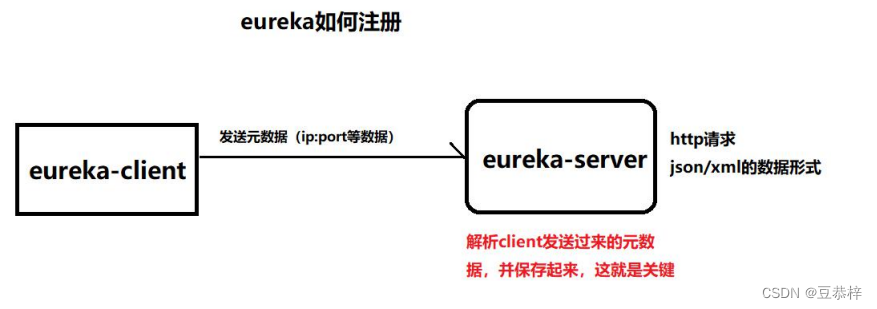
2.1 Eureka-client 发起注册请求
2.1.1 源码位置

2.1.2如何发送信息注册自己

2.1.3 真正的注册 AbstractJerseyEurekaHttpClient

总结:
当 eureka 启动的时候,会向我们指定的 serviceUrl 发送请求,把自己节点的数据以 post
请求的方式,数据以 json 形式发送过去。 当返回的状态码为 204 的时候,表示注册成功。
2.2 Eureka-server 实现注册+保存
2.2.1 接受客户端的请求
com.netflix.eureka.resources.ApplicationResource
2.2.2 源码位置
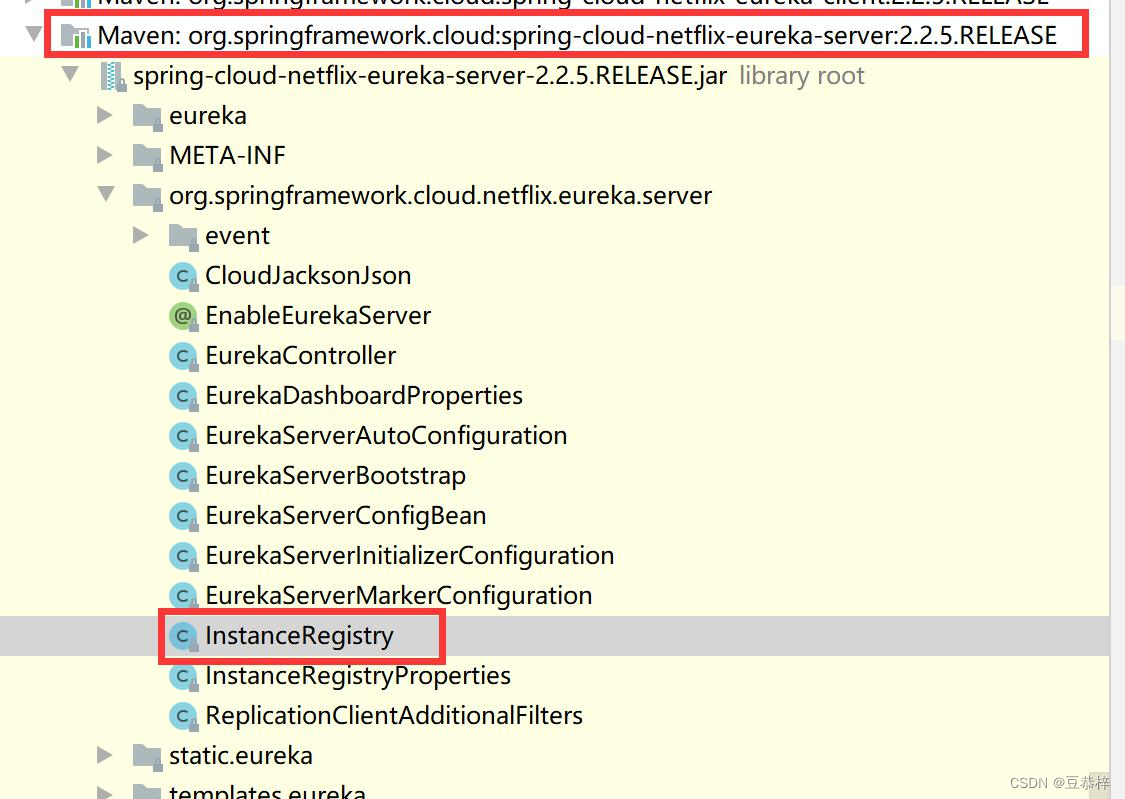
2.2.3 接受 client 的注册请求

2.2.4 处理请求(注册自己,向其他节点注册)

2.2.5 真正的注册自己

2.2.6 具体源码分析
publicvoidregister(InstanceInfo registrant,int leaseDuration,boolean isReplication){try{
read.lock();//通过服务名称得到注册的实例Map<String,Lease<InstanceInfo>> gMap = registry.get(registrant.getAppName());
REGISTER.increment(isReplication);//因为之前没有实例,肯定为 nullif(gMap ==null){//新建一个集合来存放实例finalConcurrentHashMap<String,Lease<InstanceInfo>> gNewMap =newConcurrentHashMap<String,Lease<InstanceInfo>>();
gMap = registry.putIfAbsent(registrant.getAppName(), gNewMap);if(gMap ==null){
gMap = gNewMap;}}//gMap 就是该服务的实例Lease<InstanceInfo> existingLease = gMap.get(registrant.getId());// Retain the last dirty timestamp without overwriting it, if there is already a leaseif(existingLease !=null&&(existingLease.getHolder()!=null)){Long existingLastDirtyTimestamp =
existingLease.getHolder().getLastDirtyTimestamp();Long registrationLastDirtyTimestamp = registrant.getLastDirtyTimestamp();
logger.debug("Existing lease found (existing={}, provided={}",
existingLastDirtyTimestamp, registrationLastDirtyTimestamp);// this is a > instead of a >= because if the timestamps are equal, we still take the remote transmitted// InstanceInfo instead of the server local copy.if(existingLastDirtyTimestamp > registrationLastDirtyTimestamp){
logger.warn("There is an existing lease and the existing lease's dirty timestamp
{} is greater" +" than the one that is being registered {}", existingLastDirtyTimestamp,
registrationLastDirtyTimestamp);
logger.warn("Using the existing instanceInfo instead of the new instanceInfo as
the registrant");
registrant = existingLease.getHolder();}}else{// The lease does not exist and hence it is a new registrationsynchronized(lock){if(this.expectedNumberOfClientsSendingRenews >0){// Since the client wants to register it, increase the number of clients
sending renews
this.expectedNumberOfClientsSendingRenews =this.expectedNumberOfClientsSendingRenews +1;updateRenewsPerMinThreshold();}}
logger.debug("No previous lease information found; it is new registration");}//新建一个服务的实例节点Lease<InstanceInfo> lease =newLease<InstanceInfo>(registrant, leaseDuration);if(existingLease !=null){
lease.setServiceUpTimestamp(existingLease.getServiceUpTimestamp());}//放到注册 map 的列表里
gMap.put(registrant.getId(), lease);
recentRegisteredQueue.add(newPair<Long,String>(System.currentTimeMillis(),
registrant.getAppName()+"("+ registrant.getId()+")"));// This is where the initial state transfer of overridden status happensif(!InstanceStatus.UNKNOWN.equals(registrant.getOverriddenStatus())){
logger.debug("Found overridden status {}for instance {}.Checkingtoseeif needs
tobe add tothe "
+"overrides", registrant.getOverriddenStatus(),
registrant.getId());if(!overriddenInstanceStatusMap.containsKey(registrant.getId())){
logger.info("Not found overridden id {} and hence adding it",
registrant.getId());
overriddenInstanceStatusMap.put(registrant.getId(),
registrant.getOverriddenStatus());}}InstanceStatus overriddenStatusFromMap =
overriddenInstanceStatusMap.get(registrant.getId());if(overriddenStatusFromMap !=null){
logger.info("Storing overridden status {} from map", overriddenStatusFromMap);
registrant.setOverriddenStatus(overriddenStatusFromMap);}// Set the status based on the overridden status rulesInstanceStatus overriddenInstanceStatus =getOverriddenInstanceStatus(registrant,
existingLease, isReplication);
registrant.setStatusWithoutDirty(overriddenInstanceStatus);// If the lease is registered with UP status, set lease service up timestampif(InstanceStatus.UP.equals(registrant.getStatus())){
lease.serviceUp();}
registrant.setActionType(ActionType.ADDED);
recentlyChangedQueue.add(newRecentlyChangedItem(lease));//设置心跳时间等参数
registrant.setLastUpdatedTimestamp();invalidateCache(registrant.getAppName(),
registrant.getSecureVipAddress());
logger.info("Registered instance {}/{} with status {} (replication={})",
registrant.getAppName(), registrant.getId(), registrant.getStatus(),
isReplication);}finally{
read.unlock();}}
2.3 服务注册总结
重要的类:
DiscoveryClient 里面的 register()方法完后注册的总体构造
AbstractJerseyEurekaHttpClient 里面的 register()方法具体发送注册请求(post)
InstanceRegistry 里面 register()方法接受客户端的注册请求
PeerAwareInstanceRegistryImpl 里面调用父类的 register()方法实现注册
AbstractInstanceRegistry 里面的 register()方法完成具体的注册保留数据到 map 集合
保存服务实例数据的集合:
第一个 key 是应用名称(全大写) spring.application.name
Value 中的 key 是应用的实例 id eureka.instance.instance-id
Value 中的 value 是 具体的服务节点信息
privatefinalConcurrentHashMap<String,Map<String,Lease<InstanceInfo>>> registry
=newConcurrentHashMap<String,Map<String,Lease<InstanceInfo>>>();
3 服务续约的源码分析
3.1 Eureka-client 发起续约请求
3.1.1 如何发请求续约自己
DiscoveryClient 的 renew()方法
3.1.2 真正的请求续约自己(AbstractJerseyEurekaHttpClient)
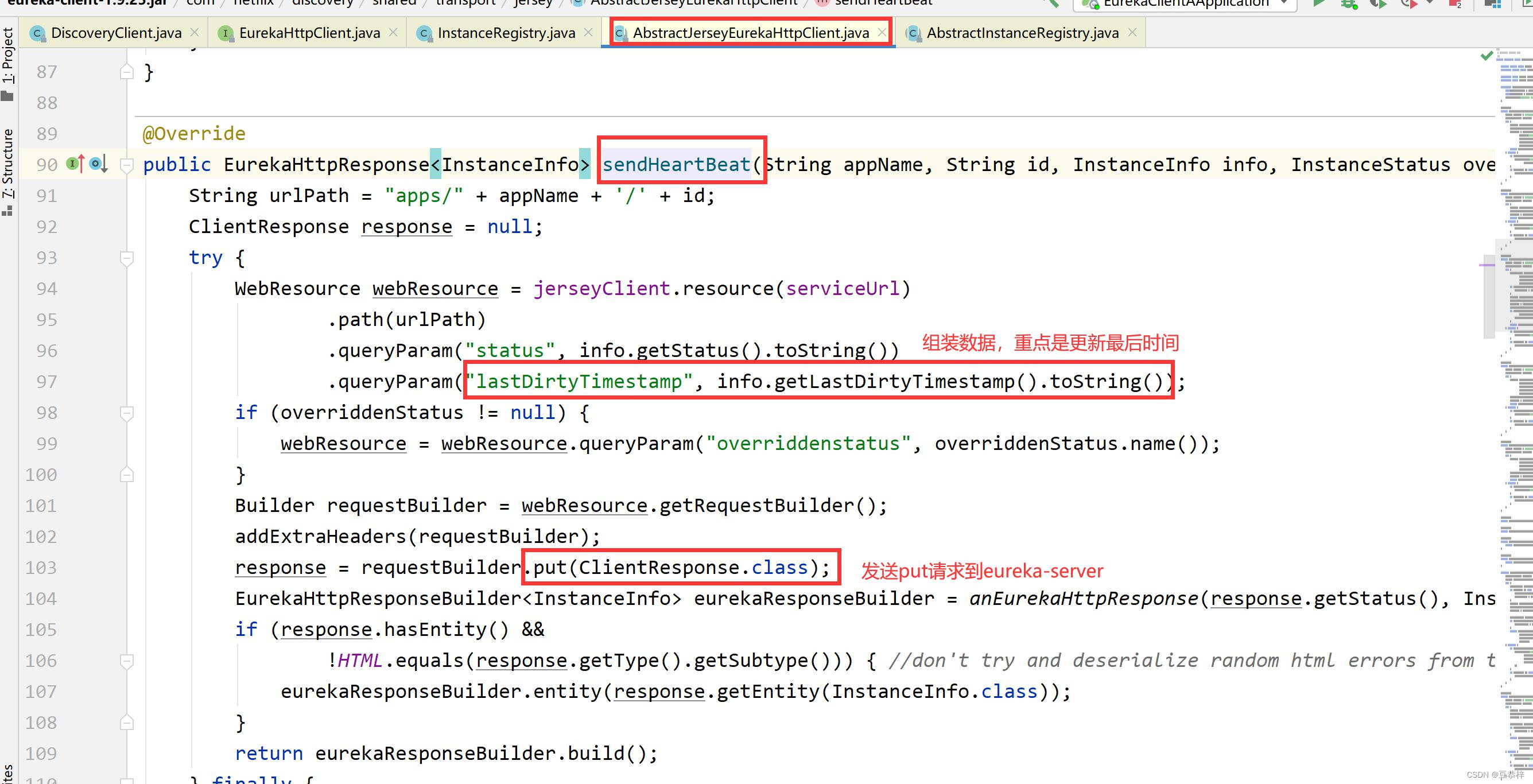
3.2 Eureka-server 实现续约操作
3.2.1 接受续约的请求
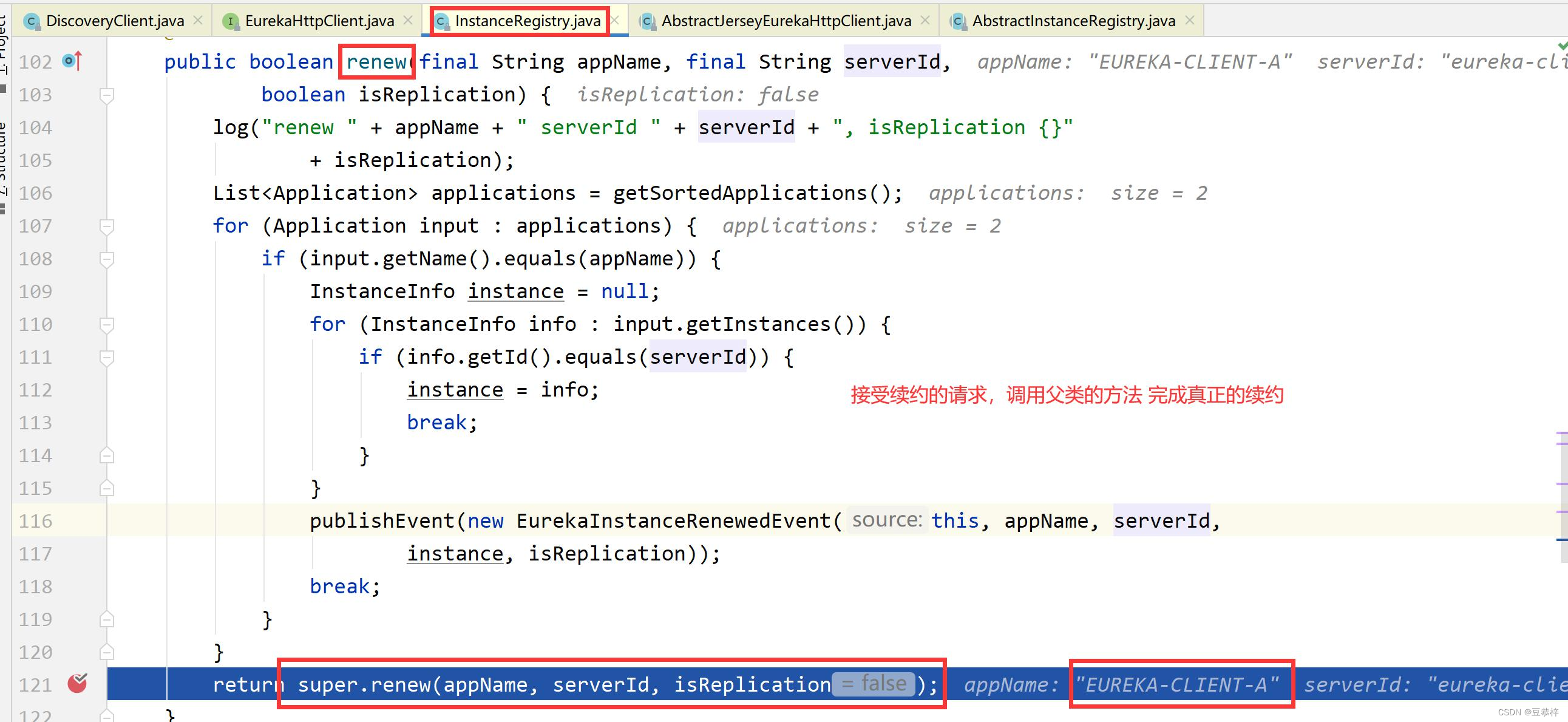
3.2.2 真正的续约
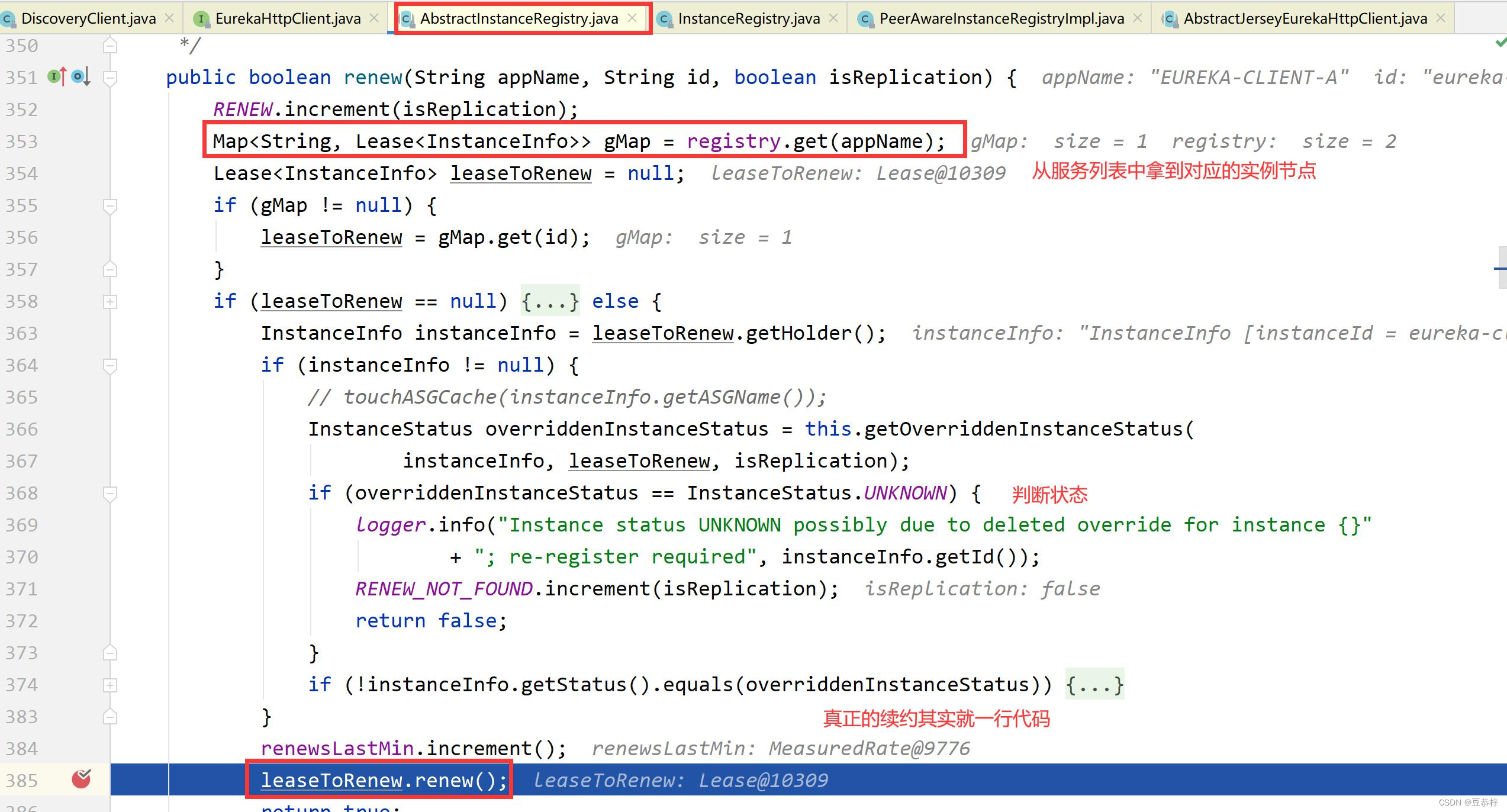
3.2.3 续约的本质
续约的本质就是修改了服务节点的最后更新时间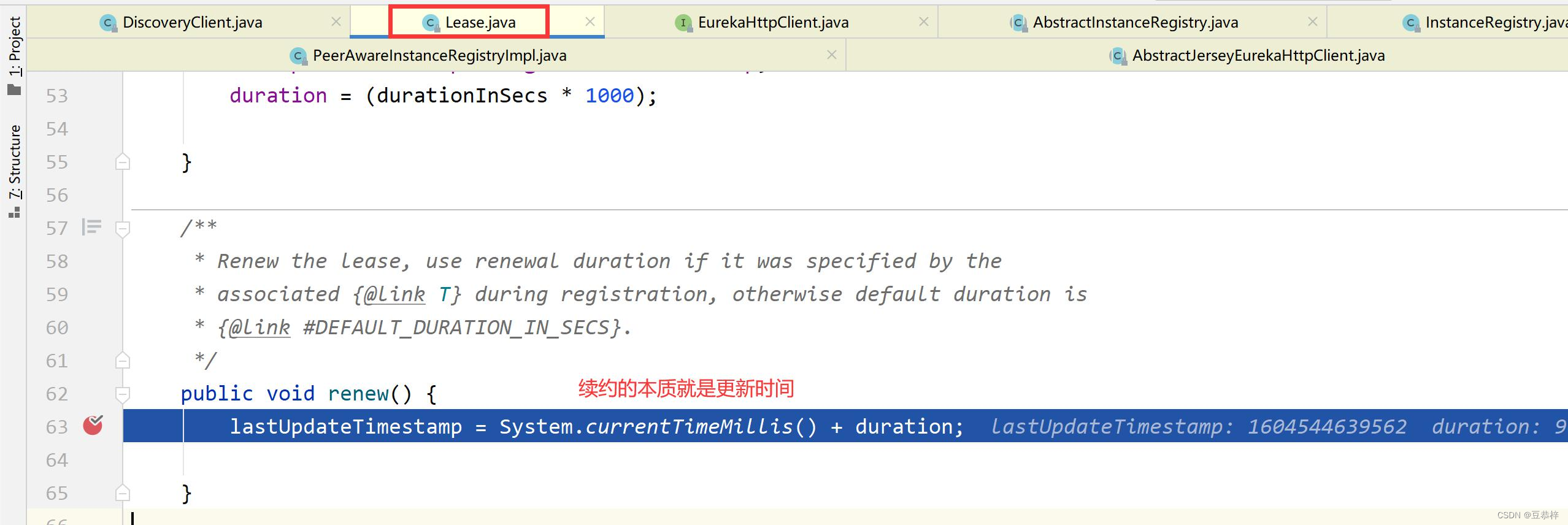
duration:代表注册中心最长的忍耐时间:
并不是 30s 没有续约就里面剔除,而是 30 +duration(默认是 90s) 期间内没有续约,才剔除服务

Volatile 标识的变量是具有可见性的,当一条线程修改了我的剔除时间,其他线程就可以立马看到(应用场景:一写多读),后面在剔除里面有一个定时任务,去检查超时从而判断某一个服务是否应该被剔除。
4 服务剔除的源码分析(被动下线)
4.1 Eureka-server 实现服务剔除
4.1.1 在 AbstractInstanceRegistry 的 evict()方法中筛选剔除的节点
publicvoidevict(long additionalLeaseMs){
logger.debug("Running the evict task");if(!isLeaseExpirationEnabled()){
logger.debug("DS: lease expiration is currently disabled.");return;}// We collect first all expired items, to evict them in random order. For large
eviction sets,// if we do not that, we might wipe out whole apps before self preservation kicksin. By randomizing it,// the impact should be evenly distributed across all applications.//创建一个新的集合来存放过期的服务实例List<Lease<InstanceInfo>> expiredLeases =newArrayList<>();for(Entry<String,Map<String,Lease<InstanceInfo>>> groupEntry :
registry.entrySet()){Map<String,Lease<InstanceInfo>> leaseMap = groupEntry.getValue();if(leaseMap !=null){//循环for(Entry<String,Lease<InstanceInfo>> leaseEntry :
leaseMap.entrySet()){Lease<InstanceInfo> lease = leaseEntry.getValue();//判断过期,加入集合中if(lease.isExpired(additionalLeaseMs)&& lease.getHolder()!=null){
expiredLeases.add(lease);}}}}// To compensate for GC pauses or drifting local time, we need to use current
registry size as a base for// triggering self-preservation. Without that we would wipe out full registry.int registrySize =(int)getLocalRegistrySize();int registrySizeThreshold =(int)(registrySize *
serverConfig.getRenewalPercentThreshold());int evictionLimit = registrySize - registrySizeThreshold;int toEvict =Math.min(expiredLeases.size(), evictionLimit);if(toEvict >0){
logger.info("Evicting {} items (expired={}, evictionLimit={})", toEvict,
expiredLeases.size(), evictionLimit);Random random =newRandom(System.currentTimeMillis());for(int i =0; i < toEvict; i++){// Pick a random item (Knuth shuffle algorithm)int next = i + random.nextInt(expiredLeases.size()- i);Collections.swap(expiredLeases, i, next);Lease<InstanceInfo> lease = expiredLeases.get(i);String appName = lease.getHolder().getAppName();String id = lease.getHolder().getId();
EXPIRED.increment();
logger.warn("DS: Registry: expired lease for {}/{}", appName, id);//这整个方法并没有真的杀死过期的服务节点//下面这个方法才是真正干掉过期的服务internalCancel(appName, id,false);}}}
4.1.2 在 internalCancel 方法里面真正实现剔除

4.1.3 在服务剔除中涉及到哪些重要的点
怎么删除一个集合里面过期的数据?
Redis 怎么清除过期的 key LRU(热点 key)
1 定时(k-thread)
2 惰性 (在再次访问该 key 时有作用)
3 定期 (使用一个线程来完成清除任务)
定期(实时性差) + 惰性
4.1.4 什么时候执行服务剔除操作呢?
查看 evict()方法在哪里调用的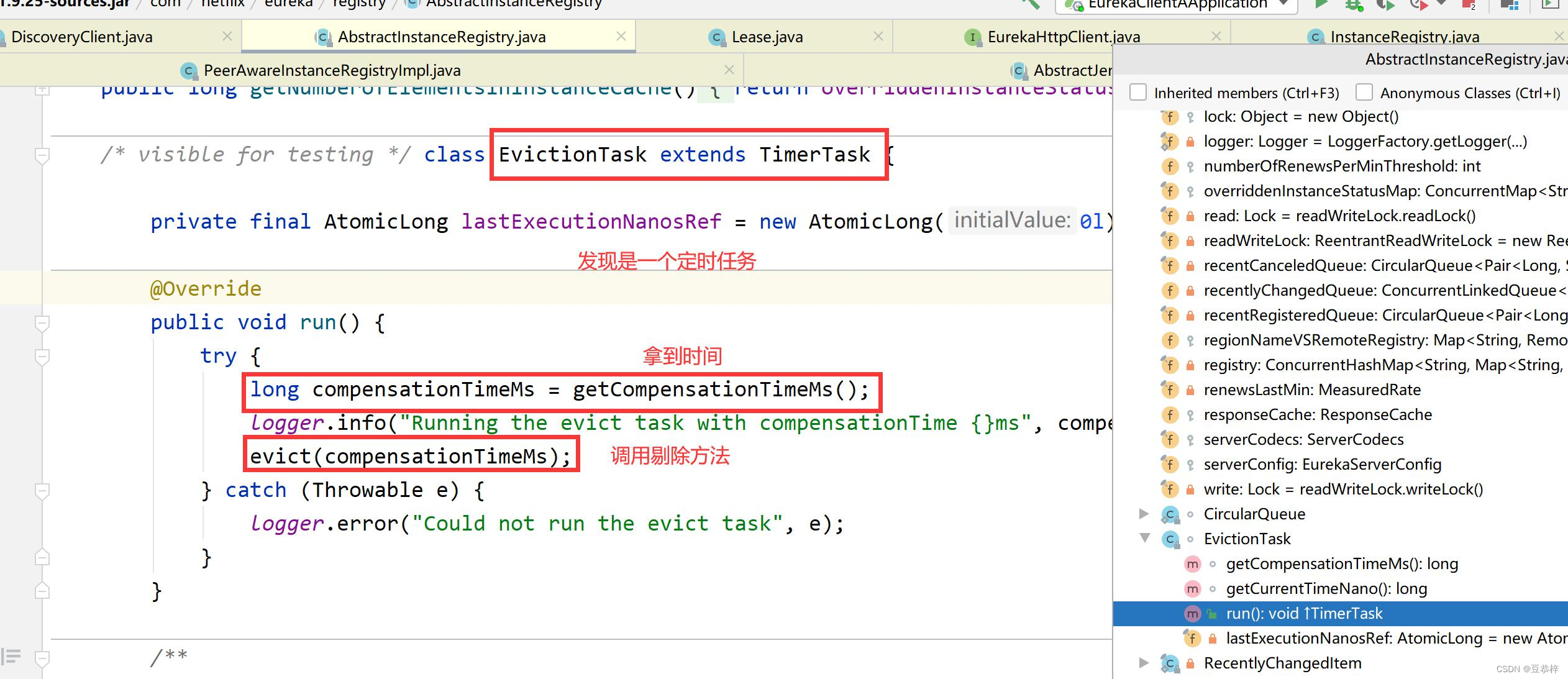
具体查看多久执行一次呢?
发现默认是 60s 执行一次
当然我们也可以自定义检测定时器的执行时间

服务下线的源码分析
5.1 Eureka-client 发起下线请求
5.1.1 如何发起下线请求
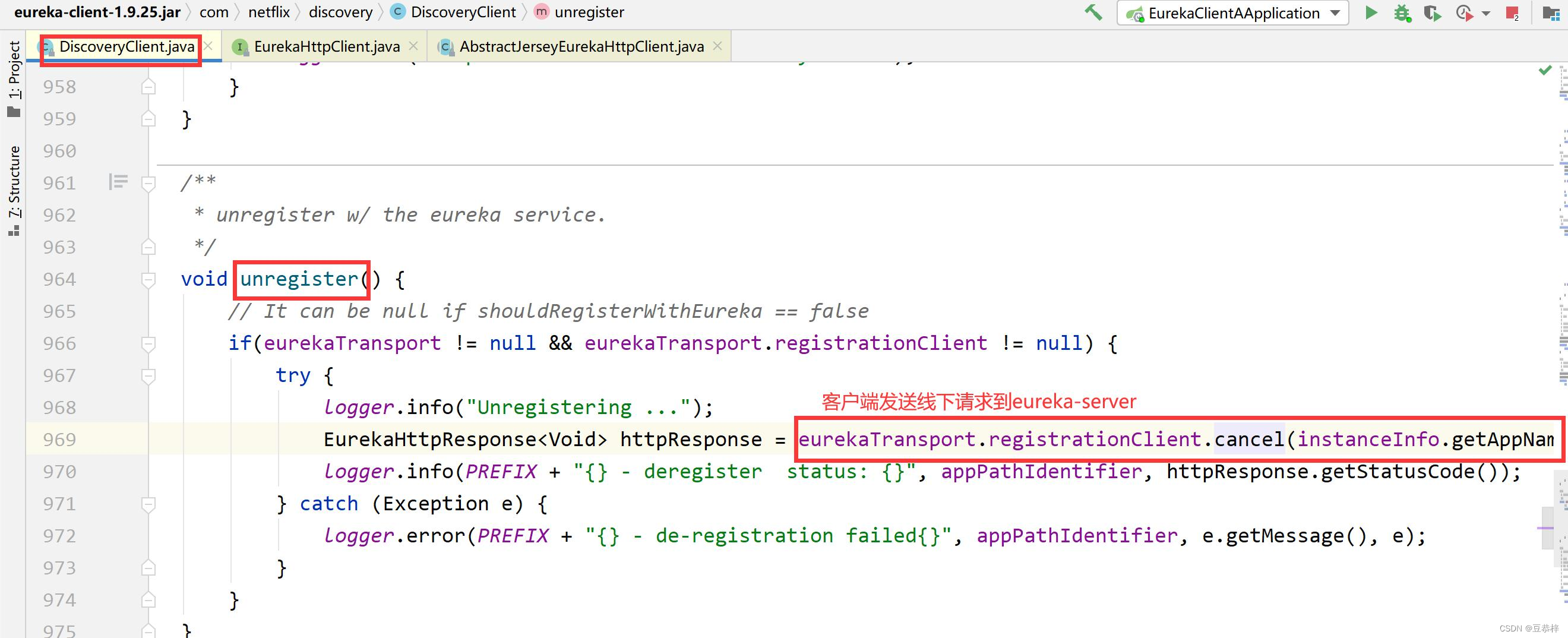
5.1.2 真正的发请求下线 AbstractJerseyEurekaHttpClient

5.2 Eureka-server 处理下线请求
5.2.1 接受下线请求

5.2.2 真正的下线服务

版权归原作者 豆恭梓 所有, 如有侵权,请联系我们删除。